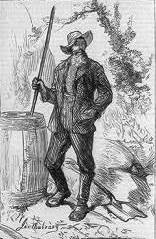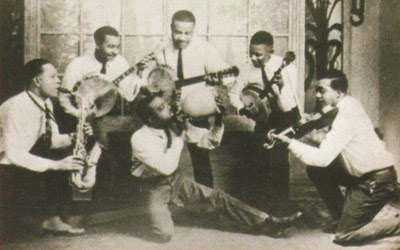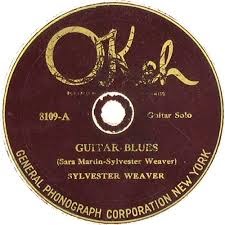Great blues cities No. 6: Louisville.
Updated: August 2nd, 2019.
“Such a tradition that has been forgotten with different genres. Thank U for what YOU are doing to preserve that, Paul.” Western New York Blues Society (@WNYBluesSociety), March 19, 2014.
Most people tend to associate Louisville, Kentucky, with bluegrass music, rather than the blues, but blues has far deeper roots in bluegrass country than you might think. Just as Kentucky’s mountain music would influence bluegrass in the 1920s, it influenced blues’ direct forbearer, ragtime, even earlier, in the 1890s.
 |
| English adventurers land in Jamestown, Virginia, in 1607. |
Kentucky. Did mountain music start here?
Mix it all up and by the nineteenth century, you had mountain music. This was long before the term ‘hillbilly’ for mountain music came into vogue, incidentally. It was this American mountain music, presumably emanating from where the Appalachian Mountains touch the Kentucky borderlands, that directly influenced the first ever ragtime song: ragtime being blues’ most distinguishable direct parent. Here’s why. In the 1870s and 1880s, different types of music were categorized by American musicians by their rhythmic tempo. Different tempos were described, for example, as ‘jig time’, ‘march time’ and ‘waltz time’. Playing a melody in short syncopated rhythms over a steady beat was called ‘ragged time’.
 |
| Louisville’s Ben Harney:
The first ragtime composer. |
In 1893, a young white vaudevillian from Louisville, Kentucky, took a melody he had composed in ragged time along to a local publisher. The vaudevillian, Ben Harney, a pianist and singer-songwriter, was just 22 when he went to see the Louisville publisher, Bruner Greenup, about publishing this new ‘raggy time’ song, as Harney called it then. Harney could play and sing the song, but he couldn’t for the life of him write it down as a musical score.
Louisville. Ragtime started here.
Generally accepted as the world’s first published ragtime, Ben Harney’s, ‘You’ve Been a Good old Wagon (Daddy) But You Done Broke Down,’ was a metaphor about an older man past his use-by date. The song was immortalised as a blues song by Bessie Smith many years later. Harney said he developed his songs in broken rhythm or raggy time, once describing his singing as ‘vocal ragging’ or ‘scatting’. This is 1893, remember, 33 years before Louis Armstrong’s ‘Heebie Jeebies’, often cited as the first song to include scatting, was recorded in 1926.
 |
| A Kentucky mountain man: 1877. |
the complexity of getting the song down on paper.
 |
| The first rag – published in Louisville, Kentucky. |
The same type of breakthrough, as I’ve posted perhaps too often before, would take place in 1912, when blues was written down and published for the first time. When finally published in 1895, You’ve Been a Good old Wagon (Daddy) But You Done Broke Down hit America with as much impact as the Beatles created in 1964. You’ve Been a Good old Wagon wrote the American academic, William H. Tallmadge, in 1995, “is of such historical importance that it should be reprinted and made available to scholars and performers interested in early ragtime music literature. The ‘(stick) dance’ that concludes the selection can be played as a ragtime piano solo even in its simplified version and it is quite remarkable for its innovations.” Ben Harney’s stick dance, according to eye-witness accounts, was a tap dance with one or both feet coordinated with a cane, as he sat and played the piano. Wrote Professor Tallmadge:
“He undoubtedly amazed his audience with this kind of tour-de-force as a dancer, singer and pianist. Old-time banjo players have been known to sing, play, and tap dance simultaneously. I suspect that Harney got the idea for his stick dance from a black banjoist or a white minstrel banjoist whom he saw in Middlesboro (Kentucky) or Louisville. It is possible that Harney’s stop-time stick dance served as the prototype for the foot-stamping, stop-time section in Scott Joplin’s ‘Ragtime Dance’ in 1906.”
Old Negro folk song: Sweet Thing.
Legendary American blues folklorists, John and Alan Lomax, wrote in 1947 that a forerunner to Good Old Wagon was the old Negro folk song, ‘Sweet Thing’, a song that had been adapted by white banjo and guitar pickers in the Appalachians in a variety of ways.
 |
| Some say this was the first ever blues song. |
The birth of blues?
That same year, Ben Harney published an even bigger seller than Good Old Wagon. Called ‘Mr. Johnson, Turn me Loose’, the song was described on its sheet music as, “A coon novelty”. Some experts say Mr. Johnson, Turn me Loose features the first published hints of the blues that would come some 18 years later. (See Great Blues Cities No. 2: New York, in this blog’s archive of 6 February 2014.)
 |
| Louisville jug band, Earl McDonald’s Dixieland Jug Blowers. |
The birth of jug bands.
There was now any number of names for these jig style bands: spasm bands, washboard bands, gut bucket bands, novelty bands or, in Louisville, jugs band. These Louisville jug bands played a mixture of Appalachian mountain music, African-American folk and ragtime. One of them, Earl McDonald’s Original Louisville Jug Band, became the first jug band to be recorded, in 1924, when they backed local blues diva Sara Martin’s ‘Blue Devil Blues.’ Sarah Martin (nee Sara Dunn, 1884 – 1955), one of the first, most popular and most recorded of the early female singers who put classic blues on the map in the 1920s, just happened to be a Louisville girl, too. Billed as ‘The Famous Moanin’ Mama’ and ‘The Colored Sophie Tucker’, Sara Martin also recorded under the names Margaret Johnson and Sally Roberts.
 |
| Sara Martin, right, with her mother in 1920. |
The first recorded blues guitar – a Louisville idea, a Louisville guitarist.
This was the first time any singer of any race had been backed solely by a guitarist. Significantly, it was also the first-ever recording of an acoustic guitarist playing blues. Sarah’s accompanist was a
26-year old Louisville guitarist called Sylvester Weaver, whom she had talent-spotted playing in a local jug band back home. Two weeks later, Weaver laid down some solo acoustic guitar tracks he called, ‘Guitar Blues’ and ‘Guitar Rag’. These tracks, recorded in November 1923, have the distinction of being the first unaccompanied recording by a black artist, the first blues guitar recordings, and the first recorded bottleneck guitar-playing in history. As an OKeh press advertisement put it back in1923:
recording, Guitar Rag, played on a banjo guitar (a six-string banjo with a
guitar neck and tuning, that quickly became the first blues guitar classic. Blues and ragtime in those days, were almost one of the same thing. Here’s the link to Guitar Rag:
 |
| Sara Martin with Sylvester Weaver. |
“The original 78 release, OKeh 8109, credited both Martin and Weaver as composers. Guitar Blues, a slow, simple instrumental, interspersed slide melodies with sparse, sliding chords. Weaver’s rollicking Guitar Rag proved to be a far more significant recording. Playing with gusto in Vastopol* tuning, Weaver conjured traces of ragtime and Hawaiian music in his memorable melodies. The song had wings. Weaver re-cut Guitar Rag in 1927 with stronger bass lines and a new middle section. It’s likely that Weaver, too, used the Hawaiian lap-style guitar technique for playing slide.”
 Sylvester Weaver’s 1923 guitar work with Sara Martin meant other blues divas now also wanted guitar accompaniment. These included the 34-year-old mistress of saucy blues innuendo, Virginia Liston, another black vaudevillian whose raunchy songs often had titles like, ‘You’ve Got the Right Key, but the Wrong Keyhole’. So, in January
Sylvester Weaver’s 1923 guitar work with Sara Martin meant other blues divas now also wanted guitar accompaniment. These included the 34-year-old mistress of saucy blues innuendo, Virginia Liston, another black vaudevillian whose raunchy songs often had titles like, ‘You’ve Got the Right Key, but the Wrong Keyhole’. So, in January1924, Listen had a guitar backing to her New York recording of ‘Jail House Blues’. For many years the guitarist was thought to be unknown, until recent expert analysis judged it to be Sylvester Weaver.
Soon afterwards, Johnson won the blues contest in
St. Louis that led to his first recording contract.
record with his mentor, Sarah Martin. Indeed, he later formed an all African-American trio called, ‘Martin Weaver Withers’, with Sarah Martin and her husband, Hayes B. Withers, on second guitar.
Weaver became largely forgotten until 1992 when his complete works were
released on Document Records, a specialist blues label, now based in Scotland.








